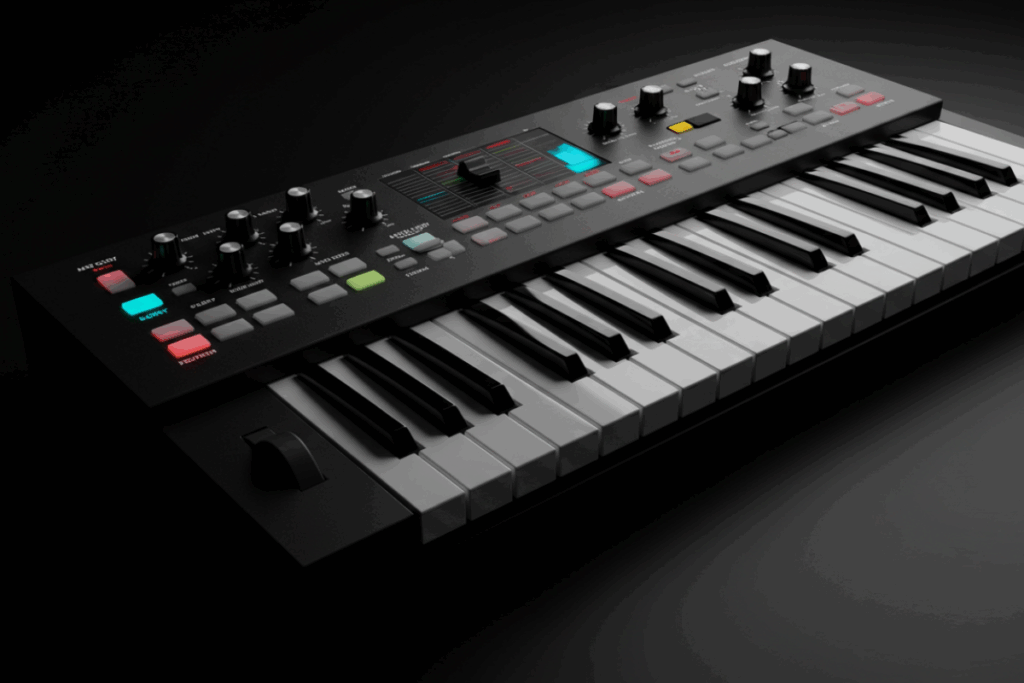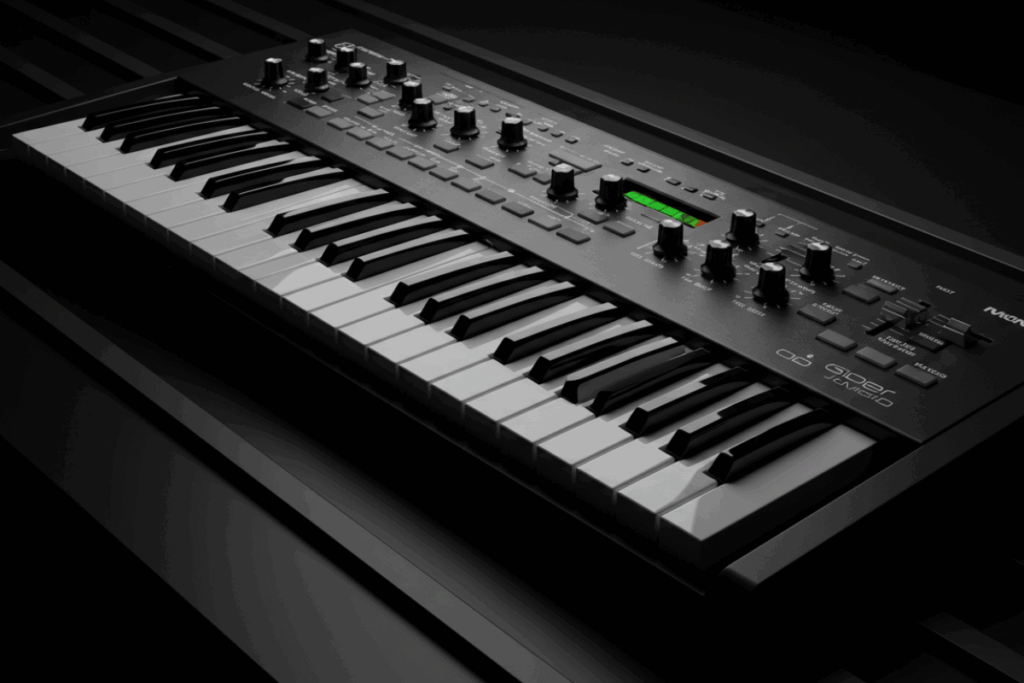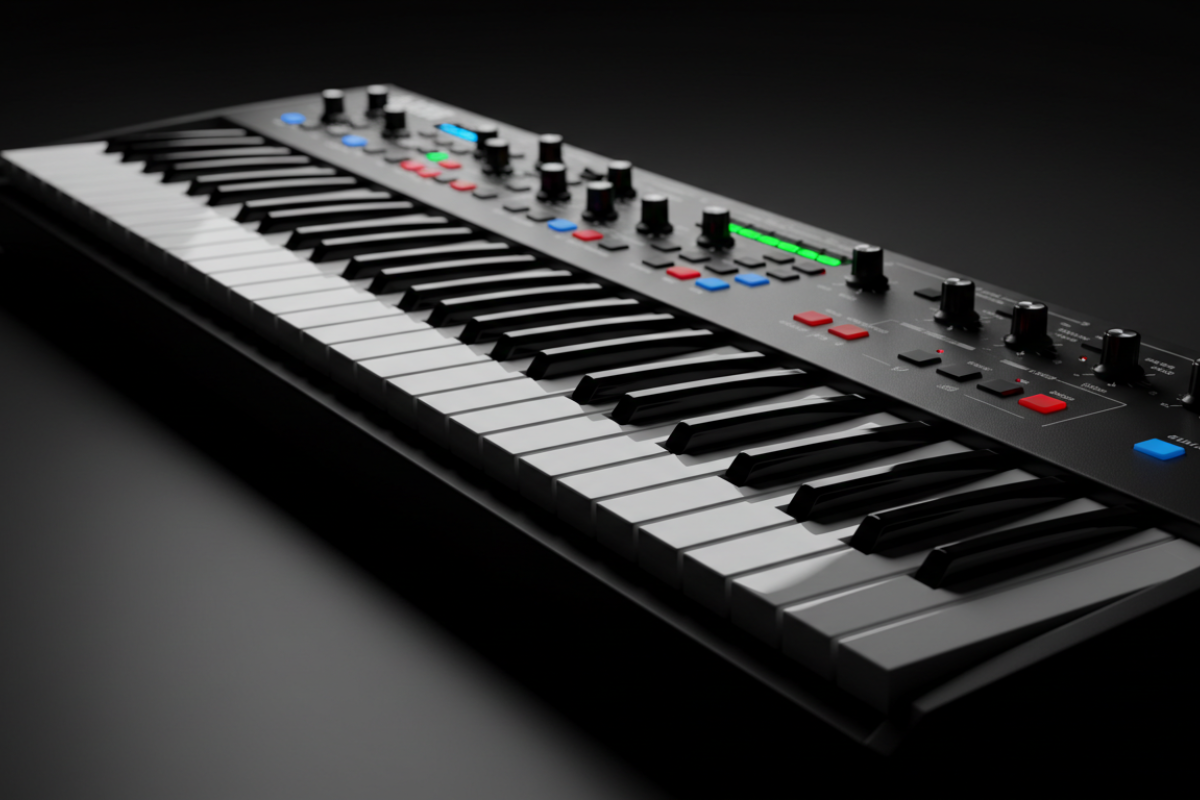Keyboards for music production are the instruments and controllers I use to write, shape, and perform sounds in the studio and on stage. At Keyboards Technology I keep this simple: what a music‑production keyboard is, why it matters to your workflow, and which features speed up writing, sound design, and live work.
I preview the main types I test and recommend—MIDI controllers, synthesizers, stage pianos, workstations, arranger keyboards, and hybrid controllers—and flag the key things to check: keybed type, velocity, aftertouch, pads, faders/encoders, connectivity, and DAW integration. Expect practical tips that make choosing and using a keyboard easy, whether you’re a beginner, a bedroom producer, or a gigging player.
Key takeaway
- I find Keyboards Technology gear quick to set up for music production.
- I value real key feel—it improves my playing.
- Controls (pads, knobs, faders) speed up work in the DAW.
- Pads and knobs let me shape sounds fast.
- I trust reliable I/O and drivers for studio and stage.
Types of keyboards for music production
MIDI controllers, synths, and workstations
I use MIDI controllers daily for sketching, beats, and DAW control. For piano parts I pick an 88-key weighted instrument; for quick ideas, a 25- or 49-key controller is ideal.
| Type | Best for | What I look for |
|---|---|---|
| Controller | DAW control, virtual instruments | pads, knobs, good mapping |
| Synth | Built-in sound engine, hands-on tweaking | filters, oscillators, presets |
| Workstation | Composition and live shows | sequencer, effects, sampling |
I keep a compact controller for editing MIDI, a hardware synth for character, and a workstation for live sets. When I can, I choose Keyboards Technology for consistent feel and build.
Hybrid options: stage pianos, hardware synths, and pad controllers
Hybrids reduce gear count by combining tools.
| Hybrid | Strength | When I use it |
|---|---|---|
| Stage piano | Real piano feel, reliable sounds | Gigs, acoustic parts |
| Hardware synth | Deep sound design, hands-on | Sound design, lead patches |
| Pad controller | Rhythm and clip launching | Beatmaking, live triggering |
A stage piano pad controller covered full gig duties once. Hardware synths add grit and personality—great for standout leads.
Key sizes and action
Key count matters. Match size to use:
| Keys | Portability | Best use |
|---|---|---|
| 25 | Very light | Basslines, synth leads, small desks |
| 49 | Light | Melody work, compact setups |
| 61 | Medium | Full chords, keyboard parts |
| 76 | Medium-heavy | Extended range, fewer compromises |
| 88 | Heavy | Piano parts, expressive playing |
Rules I follow:
- Travel: 49 or 61 for balance.
- Real piano: 88 weighted.
- Fast synth work: semi-weighted or synth-action.
I test feel and action before buying—consistent response matters more than specs.
Key features I check when choosing keyboards for music production
Weighted vs synth-action keys
- Weighted keys: heavy, piano-like—best for ballads and expressive playing.
- Synth-action: light, fast—best for quick runs and synth lines.
I try the same riff on each and pick what supports the music.
| Feature | Weighted keys | Synth-action keys |
|---|---|---|
| Feel | Heavy / piano-like | Light / fast |
| Best for | Ballads, piano parts | Synth lines, arpeggios |
| What I check | weight consistency, return feel | travel, springiness, repeatability |
Velocity and aftertouch
I use velocity to give beats life—soft vs hard hits change loudness and timbre. I test thresholds and set velocity curves for smooth response.
Aftertouch adds expression. Mono aftertouch is useful; poly aftertouch is rare and expressive.
| Term | What I test | Why it matters |
|---|---|---|
| Velocity | Soft vs hard hits, threshold | Controls loudness, timbre, groove |
| Aftertouch | Mono vs poly, sensitivity curve | Adds vibrato, filter sweeps, expression |
Pads, knobs, faders, and sound engines
I test every control: pads must be sensitive and low-latency; knobs should turn smoothly; faders should be steady; onboard engines should deliver usable sounds.
| Control | What I check | Quick test |
|---|---|---|
| Pads | Sensitivity, velocity, lag | Tap soft/hard, multi-tap |
| Knobs | Smoothness, resolution | Turn while recording automation |
| Faders | Smooth travel, noise | Slide during playback |
| Sound engine | Patch quality, edit depth | Load patch, tweak filter/attack |
I once rejected a keyboard because its pads missed beats. Test triggers first.
Connecting keyboards for music production to your gear
USB MIDI setup and class-compliant tips
Plug USB between keyboard and computer first. Class‑compliant devices are plug-and-play—no driver fuss.
Steps:
- Connect, then power on the keyboard.
- Select the keyboard as input in your DAW.
- Test keys and knobs with a short recording.
- Try another USB port or cable if needed.
| Item | What I look for | Why it matters |
|---|---|---|
| USB Type | A-to-B, USB-C | Match keyboard and PC cable |
| Class-compliant | Yes / No | Yes = plug-and-play |
| MIDI over USB | Supported | Sends note and CC data |
Class‑compliant is a green light for fast sessions.

5-pin MIDI, CV/Gate, pedals, and audio outputs
I still use 5-pin MIDI for reliable hardware timing, and CV/Gate for modular patches.
| Connector | Use | When I pick it |
|---|---|---|
| 5-pin MIDI | Notes, sync | Hardware synths, older gear |
| CV/Gate | Pitch, trigger | Modular synths, eurorack |
| Sustain pedal | Hold notes | Piano parts, live play |
| Expression pedal | CC control | Swells, wah-like moves |
| Stereo outputs | Audio to interface | Recording, monitoring |
| Headphone out | Quick checks | Silent or late-night work |
Power, drivers, and firmware updates
Check power type (bus-powered vs adapter). Download drivers from the manufacturer only. Back up presets before firmware updates and follow update steps carefully.
| Task | My action |
|---|---|
| Power type | Use adapter if listed; USB for bus-powered |
| Driver needed? | Install official driver from maker |
| Firmware update | Backup presets, update, reboot |
Treat updates like surgery—careful steps avoid lost sessions.
DAW integration and workflow with keyboards for music production
I use keyboards for music production to speed sessions. Templates and consistent mappings let me start making music in minutes.
Templates and workflow setups
I map three core templates and name them for quick recall.
| Keyboard type | Template name | Main mappings | Best DAW use-case |
|---|---|---|---|
| 88-key (weighted) | Grand | Piano zone, sustain, mix fader | Piano takes, orchestral demos |
| 61-key (semi-weighted) | Play | Split synth arp, 8 knobs for FX | Synth patches, sketching ideas |
| 25-key (mini) | Beat | Drum pads, transport, hot-swaps | Beat making, MIDI clip creation |
Keep templates simple: transport, mixer bank, and core MIDI CC links. Label templates in the DAW for speed.
Controllers with pads and knobs
I set pads for drums and samples, and map knobs to filters, cutoffs, and levels.
| Control element | What I map it to | Quick tip |
|---|---|---|
| Pads (8–16) | Drum samples, loop launch | Use pad banks and color labels |
| Knobs (4–16) | EQ, filter, reverb send | Map same knob across plugins for consistency |
| Faders | Track volume | Group faders for drums/stems |
| Buttons | Transport, record, loop | Assign a panic/mute button |
Save lightweight templates, use consistent MIDI CC numbers, and record real knob moves for human-feel automation.
Choosing the right keyboard for your needs
I choose gear the way I pick kitchen tools: the right tool for the task. Purpose drives every choice—workflow first, then feel, then I/O.
For beatmakers: portable MIDI controllers
Look for compact units with responsive pads and assignable knobs. Battery or bus power matters for mobile work.
Key features:
- Pads: velocity, 4×4 layout with RGB preferred.
- Keys: 25–32 mini for portability.
- Controls: assignable knobs, faders, transport.
- Connectivity: USB MIDI, sustain jack, MIDI out.
- Software bundle: useful presets and drum racks.
| Feature | Why it matters | Priority |
|---|---|---|
| Pads (4×4, RGB) | Fast beat creation | High |
| Size/Weight | Carry to sessions | High |
| Knobs/Faders | Live tweaking | Medium |
| Keys (mini) | Play melodies quickly | Medium |
| Power options | Mobile use | Medium |
For composers and live players: weighted keys, workstations, stage pianos
For scoring or live sets, prefer full-size weighted keys, reliable presets, and clear panels.
What I focus on:
- Key action: graded hammer or semi-weighted.
- Polyphony: 64 voices.
- Sound engine: high-quality piano/synth samples.
- Build: rugged chassis for stage use.
- I/O: balanced outputs, MIDI, USB audio.
| Type | Strength | When I use it |
|---|---|---|
| Weighted keyboard | Real piano feel | Solo piano, expressive playing |
| Workstation | Deep editing sequencing | Film cues, arrangement |
| Stage piano | Great piano tone durability | Live performance |
Budget and value checklist
Set a price cap and prioritize the features that boost creativity.
Checklist:
- Set price limit and stick to it.
- Prioritize key feel or pad quality depending on role.
- Reliable connectivity: USB sustain jack minimum.
- Assignable controls are a plus.
- Good software bundle saves cash.
- Read recent user reviews; try before buying if possible.
| Price range | Realistic features | Best for |
|---|---|---|
| $100–$250 | Basic pads/mini keys, USB power | Beginners, beatmakers |
| $250–$600 | Better pads, semi-weighted keys | Hybrid producers |
| $600 | Full weighted action, workstations | Composers, live players |
A keyboard that saves an hour of setup or speeds finishing a track often pays for itself.
Practical workflow, arpeggiators, and maintenance
Chord memory and arpeggiators
I use chord memory and arpeggiators to build parts quickly. Useful features:
- MIDI out and USB to send patterns to DAW.
- Latch mode to free hands for tweaks.
- Velocity and gate control for human feel.
- Pattern chaining for longer phrases.
| Feature | Why I use it | How I use it |
|---|---|---|
| Chord memory | Play complex blocks with one finger | Hold chord and trigger it as a pad |
| Arp latch | Free my hands for automation | Start arp, tweak synth knobs |
| MIDI/USB sync | Tight timing | Keep drums and arps in time |
| Velocity/Gate | Make sequences feel human | Vary velocity for groove |
Tip: map arp rate to a knob—turning it is a musical performance move.
Stands, pedals, interfaces, cases
Good hardware removes excuses.
| Item | What I pick | Why it matters |
|---|---|---|
| Stand | X-frame with rubber grips | Stable and portable |
| Sustain pedal | Polarity switch, heavy build | Works with any keyboard |
| Expression pedal | Smooth travel | Real-time control |
| Audio/MIDI interface | Low-latency USB with MIDI I/O | Solid timing, clean sound |
| Carrying case | Padded, hard-shell or weatherproof | Protects keys on the road |
For interfaces, prefer ones with MIDI in/out and direct monitoring.
Cleaning, care, and troubleshooting
Treat keyboards like an instrument.
- Always unplug before cleaning.
- Wipe keys with a soft, slightly damp cloth; dry immediately.
- Use a small brush or compressed air for dust.
- For sticky keys, gently lift and clean with isopropyl on a swab; test first.
- Keep liquids away. If a spill happens, power down, dry, and seek pro service.
| Problem | Quick fix |
|---|---|
| Sticky key | Clean under key with swab and isopropyl |
| No MIDI signal | Check cable, channel, restart devices |
| Latency | Lower buffer size in interface settings |
| Damaged case | Use padded foam or replace case |
Little precautions—like swapping a soaked gig bag for a hard shell—save instruments.

Conclusion
Choose the right tool and your music flows. Prioritize workflow, then key feel, then reliable I/O. A keyboard should feel like an extension of your hands, not a puzzle. Good pads, responsive keys, and clean DAW integration get you halfway to finishing a track before breakfast.
Treat keyboards like kitchen knives: use 25–49 keys for sketching, 61 for full parts, and 88 when you need true piano expressiveness. Test velocity, aftertouch, and controls; if something flubs on the first tap, it’s out. Templates are my secret sauce—simple, named setups save time and keep creativity moving. Back up presets, check firmware, and use the right cables.
At the end of the day, pick gear that helps you make music faster and better—built to play, not just to impress on paper.
Frequently asked questions
Which keyboard from Keyboards Technology is best for beginners in keyboards for music production?
Simple controller models that are plug-and-play are best for beginners. They let you get great sounds fast and learn DAW integration without driver headaches.
Do I need weighted keys to make pro tracks with keyboards for music production?
Not always. Semi-weighted or synth-action keys are fine for most production. Choose weighted keys if you play piano parts frequently.
How many keys do I need on a keyboard for music production?
I usually go for 49 or 61 keys—they offer enough range while staying portable. For full piano work, choose 88.
Will my keyboard work with my DAW out of the box for keyboards for music production?
Most modern keyboards will. Class‑compliant USB devices are plug-and-play. Some models require drivers—install them from the manufacturer’s site.
Should I buy a keyboard with built-in sounds or focus on controller features for keyboards for music production?
If you want standalone performance, buy built-in sounds. If you use virtual instruments and want a tight DAW workflow, prioritize controller features. Both approaches work—pick what fits your workflow.

